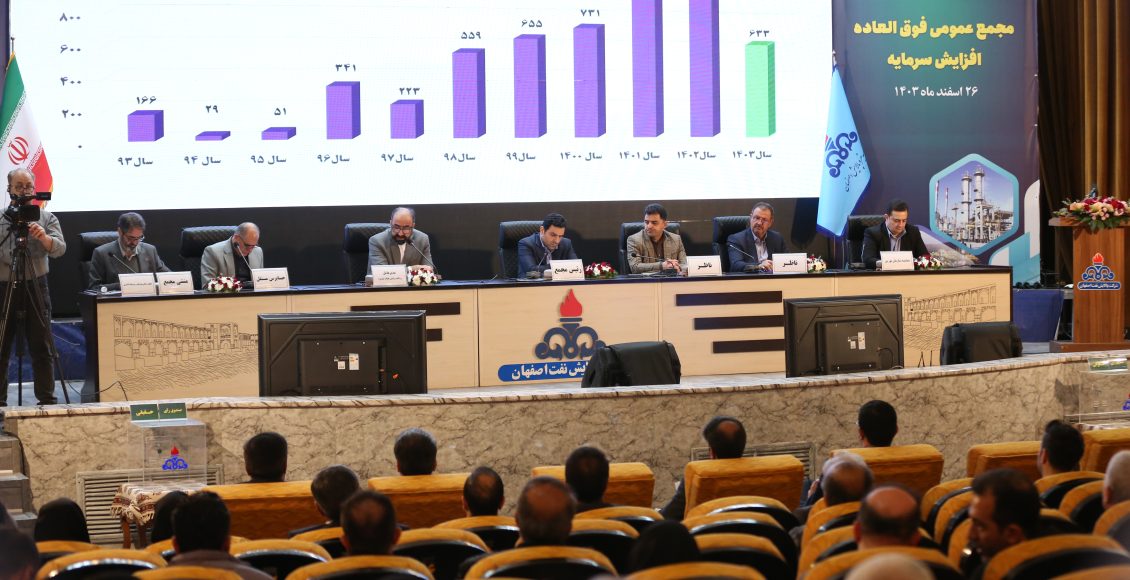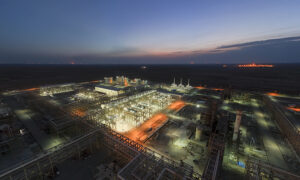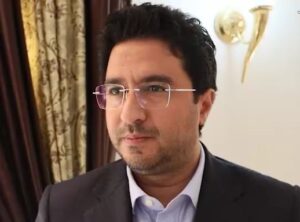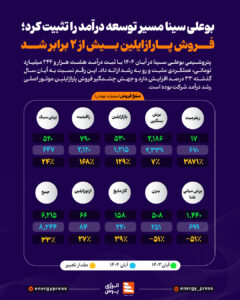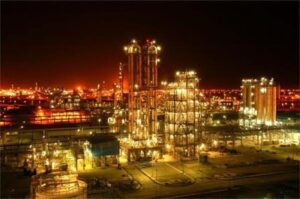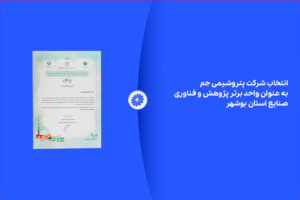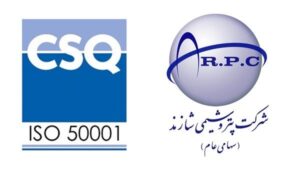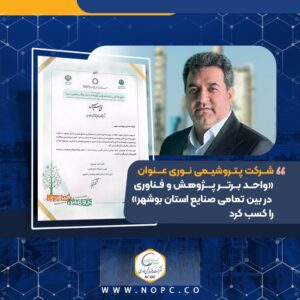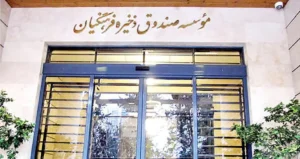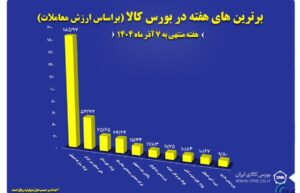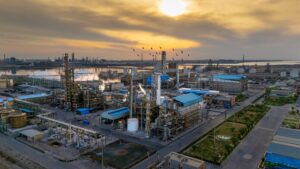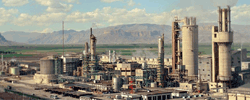The extraordinary general assembly of EORC to increase the capital was held on March 16, 2025, with the attendance of 69.37 percent of the company’s total shareholders. The CEO of Isfahan Oil Refining Company said in this meeting that the value of this company is currently about 191 trillion tomans. Gholamreza Bagheri Dizaj, stated that the change in the formula for the price of crude oil and oil products, the mandated prices for some products, as well as the approximately 30 percent increase in the price of gas consumed by companies caused the company’s net profit to decrease in the first nine months of this year compared to the same period last year. He added that the company’s net profit in the first nine months of 1402 was about 32 trillion tomans and has decreased to 16.5 trillion tomans this year, which is expected to be 633 rials per share of Isfahan Oil Refining Company in 2024/2025.
He said that Isfahan Refinery currently supplies 16 percent of the country’s liquefied gas, 13 percent of kerosene, 12 percent of gasoline and 21 percent of diesel fuel, and 12 percent of fuel oil. With the operation of the Isfahan Oil Refining Company’s comprehensive plan, the fuel oil produced will be converted into valuable products such as gasoline and diesel fuel, and the refinery’s share of oil product production will change. The CEO of the Isfahan Oil Refining Company further noted that the implementation of the Kerosene Treatment Unit (KHT), the Desulfurization Unit from the Distillation Towers’ Residues (RHU), and the Fluidized Bed Catalytic Cracking Process Unit (RFCC) are among the most important projects being implemented by the Isfahan Oil Refining Company. He said the Kerosene Treatment Unit project is 90 percent complete and will be put into operation in the spring of 2025. Bagheri Dizaj said with the operation of the Kerosene Treatment Unit (KHT), the sulfur content of the Isfahan Refinery’s kerosene will be reduced from 3,000 PPM to one PPM.
He stated that in order to improve the quality of fuel oil produced by the Isfahan Refinery, a plan for the desulfurization unit from the distillation tower residues (RHU) and also the fluidized bed catalytic cracking process unit (RFCC) has been defined. He added that 580 million euros have been invested in the implementation of the desulfurization unit from the distillation tower residues. The CEO of the Isfahan Oil Refining Company announced the progress of the (RHU) unit project at 66 percent and said this unit will be put into operation by the end of 1405. Bagheri Dizaj added the desulfurization unit from the distillation tower residues will produce sweet fuel oil in the first phase, and its profitability is estimated at 156 million euros in 2015, and its return on investment period will be 6 years in the worst case.
Stating that in the fluidized bed catalytic cracking unit (RFCC), sweetened fuel oil will be converted into valuable petroleum products such as gasoline, diesel, and propylene as petrochemical feedstock, he said this unit has progressed by about 13 percent and will be operational by the end of 2029. The CEO of Isfahan Oil Refining Company announced the investment amount for the construction of the fluidized bed catalytic cracking unit of the Isfahan refinery as 880 million euros and added that the profitability of this unit is 264 million euros per year and the return on investment period is 3.5 years. Bagheri Dizaj said by operating this project, in addition to increasing the production of gasoline and diesel at the Isfahan refinery, 220,000 tons of propylene will also be produced annually.
He stated that currently, about 250 tons of sulfur are produced daily in the Isfahan refinery, and by operating the desulfurization unit from the bottom of the distillation towers (RHU) and the fluidized bed catalytic cracking process unit (RFCC), the amount of sulfur produced by the Isfahan refinery will exceed 700 tons. He added to manage this volume of sulfur produced and convert it into a product with higher added value, the construction of an ammonium sulfate and ammonia recycling unit has been defined with an investment of 35 million euros. This project is currently 23% progress and will be put into operation in 1405. The CEO of the Isfahan Oil Refining Company said: This company is currently constructing a 215-megawatt solar power plant, the first phase of which is to produce 50 megawatts of electricity.
Bagheri Dizaj stated that the Isfahan Oil Refining Company has several projects underway to provide sustainable water and optimize water consumption at the refinery, including the construction of hybrid coolers, purification and recycling of refinery wastewater, construction of 6 strategic tanks with a capacity of 50,000 cubic meters, and participation in the implementation of the transfer plan from the Sea of Oman to supply industries in Isfahan province. He said by utilizing these projects, the water consumption of the Isfahan Refinery will be reduced by 75 percent, so that water consumption will be reduced from 1,200 cubic meters per hour to 300 cubic meters per hour. The CEO of the Isfahan Oil Refining Company further stated that the security in the Energy City is an integrated and interconnected issue.
Dr. Gholamreza Bagheri Dizaj added water shortage is one of the threats to the refinery, which fortunately will be resolved with the water transfer plan from the Sea of Oman to the Isfahan Refinery. He said in the past three months, the Isfahan Refinery has made a great effort to contribute to the water transfer project. Bagheri added currently, the Isfahan Refinery meets its water needs by receiving 500 cubic meters of wastewater from Shahinshahr and 700 cubic meters of water from the province, which with the full implementation of the water transfer plan will not need drinking water and will reduce the need for wastewater.
He stated in the field of energy, the Isfahan refinery will also produce its own electricity, and if the financial issues are resolved, the Isfahan refinery can make an important contribution to solving the electricity imbalance by producing 50 megawatts of solar electricity and injecting it into the national electricity grid. He noted that by implementing the RHU project and sweetening fuel oil, the company will play a significant role in reducing the imbalance in gas fuel consumption. Also, by sweetening fuel oil, power plants can use this fuel without any worries and without any taxes or pollution. The CEO of the Isfahan Oil Refining Company continued that in the RHU project, by sweetening fuel oil, the amount of gas used in industries will be released, and the feedstock for downstream and petrochemical industries will be supplied through refined fuel oil, and the problem of gasoline and fuel imbalance will be resolved.
He stated that the second phase of the project, called RFCC, the sweet fuel oil produced will be converted into high-quality and more value-added products such as Euro 5 gasoline and diesel, and will be the feedstock for downstream industries, especially petrochemicals. Bagheri referred to the importance of the projects and the density of various industrial centers in the Energy City and said the issue of security in this complex is integrated and interconnected.

